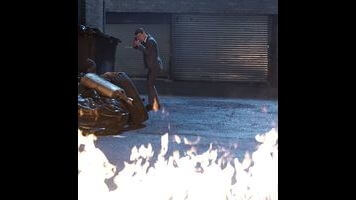“Rise Of The Villains: Scarification” presents the beginnings of Firefly. This iteration sees the role taken on by Bridgit, a young woman who runs with the arsonist gang the Pike Brothers and has a shared past with Selina Kyle. Here she’s a reluctant participant, at least initially. When Galavan enlists Penguin to burn down a number of buildings across Gotham, Penguin realizes he’s not the right man for the job and sends Butch to purchase the services of the Pike Brothers. They agree to the job but the death of their smallest brother means they need someone new to sneak into air ducts and light fires for fun and chaos. They force Bridgit into their plan, using her to light fuses in four different buildings and stealing an old knife from one of them.
As fun as it could be to see Firelfy take shape, especially considering that Gotham hints at a backstory for Bridgit that’s tied in with Selina and the Pike Brothers, “Scarification” settles into the pandering origin story groove that made up much of the show’s first season. There’s no depth or nuance to the characterization of Bridgit/Firefly. She’s merely an abused and broken woman who’s drawn into the life of the Pike Brothers for reasons Gotham feels no need to explain. That lack of nuance and depth is even more troublesome when focusing on the Pike Brothers. Their entire existence, and Leo Fitzpatrick’s whole performance, is defined by scowling, grunting, and more scowling. Gotham has a habit of making its villains into oversized cartoon characters and that works every so often, but the cheesy, inconsistent, personality-less Pike Brothers take that to the next level. “Scarification” presents the Pike Brothers as this infamous, dangerous band of criminals, and yet there’s no edge to their characterization. As with Firefly it’s another case of Gotham coasting on the canon name, hoping that the name recognition alone will distract from the fact that there’s nothing beneath the surface.
Gotham has been at war with itself since its very first episode, and maybe even before that when Bruno Heller and company decided to do a Batman show that had no Batman and a second season subtitled “Rise Of The Villains” while knowing that the timeline doesn’t allow for any substantial, long-term villains, outside of maybe Penguin, to really grow. What I mean about the show being at war with itself is that Gotham has always embraced its more cartoonish elements and, through the way the show is written, shot, and marketed, expected the audience to engage with the show on those terms. While it’s doing that though Gotham is also urging viewers to treat it as a show with gravitas and grit, to move beyond those cartoonish elements and see the murky morality of the titular city. It’s a classic case of a TV show having its cake and eating it too, and “Scarification” is the embodiment of Gotham being unable to strike a proper balance, or rather, commit to a single tone that would serve to make the show more cohesive week in and week out.
This season has largely been working towards cementing that sense of gravitas by introducing new villains and really focusing on Gordon’s struggle to clean up Gotham while being unaware that his new political partner, and now officially endorsed mayoral candidate, Theo Galavan has an age-old blood feud with the Waynes and is ready to burn Gotham to the ground. The dialogue is “Scarification” readily uses words like “hope,” “leader,” “inspiration,” and “respect” to talk about Jim Gordon and his crusade, and yet there’s never been anything to suggest that what Gordon is doing is noble. Sure, he’s locked up a few guys that other cops might not have, but that’s about it. Again, the extent of Gotham‘s character work is endless description, where noble, brave, and loyal are words used by tertiary characters to describe main characters, not actual qualities that we can see challenged or deployed from one episode to the next.
“Scarification” is Gotham in a nutshell, an episode that’s narratively scattered and consistently uninterested in moving along meaningful and engaging plotlines, and also deepening the show’s ever-expanding roster of characters.
Stray observations
- Never Mind The Bullocks: “Yay, a stakeout. I’ll buy the donuts.” Donal Logue is playing a high school drama kid playing a hardboiled cop at this point and it’s still the best part of the show.
- There’s one solid joke tucked into “Scarification.” When the episode shifts its focus to The Merc, the warehouse where all the local criminals buy their weapons, the echoing PA system states “can we get a price check on brass knuckles in toxic green?” It’s a shame the PA kept going after that, beating the joke into the ground, but such is the way of Gotham.
- Come to Gotham for the half-baked characters, stay for the fondu jokes.
- “Fire is our bread and butter. It’s the family business.” Yeah, the Pike Brothers are really the most generic, undercooked villains this show has seen so far.
- Jim Gordon’s police work involves looking at a map of buildings that were burnt down and literally pointing at the next one and saying, “that’s the obvious next target.”












![HBO teases new Euphoria, Larry David, and much more in 2026 sizzle reel [Updated]](https://img.pastemagazine.com/wp-content/avuploads/2025/12/12100344/MixCollage-12-Dec-2025-09-56-AM-9137.jpg)




























